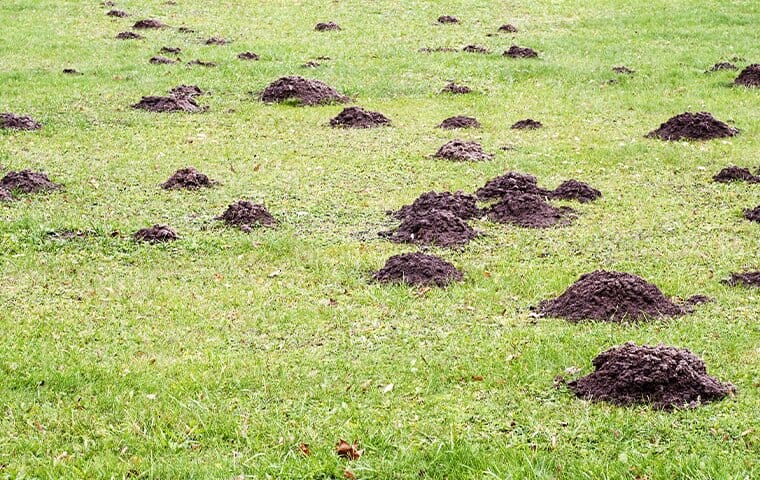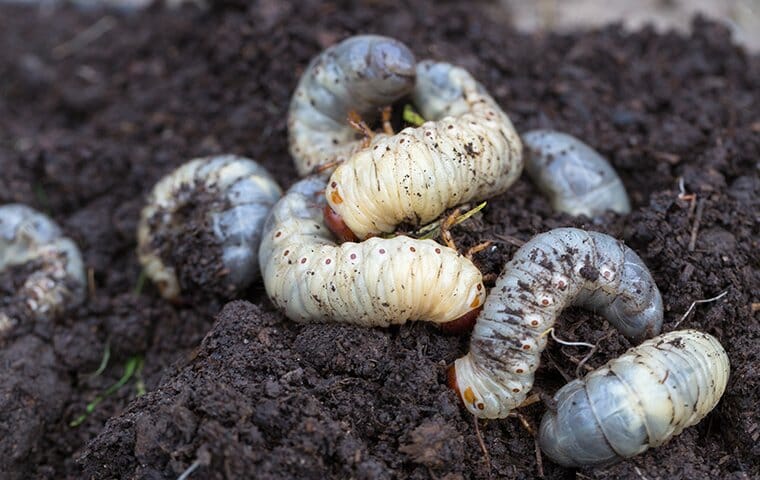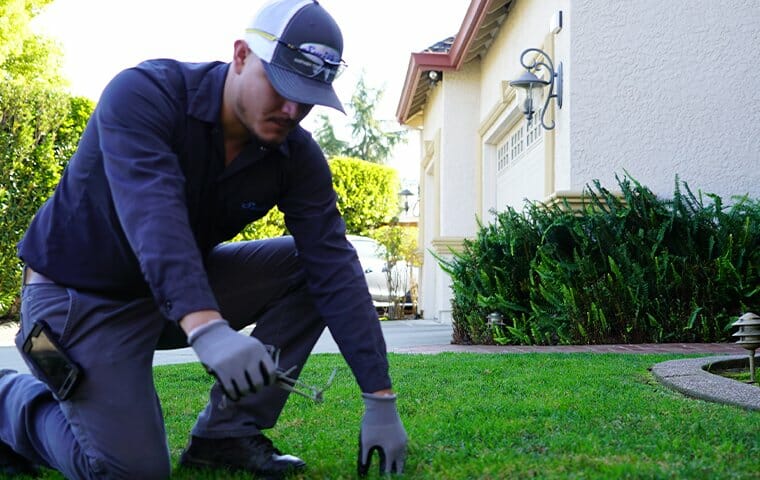How to Get Rid of Moles in Your Lawn
Moles: while some people think they look cute, they can cause severe damage to your lawn and landscaping.
Moles construct intricate networks of tunnels and mounds in the ground and quickly kill or damage the plants, grass, and trees in your outdoor space. If you want to reclaim your yard, the only solution is to learn how to get rid of moles.
Don't worry – it is possible to figure out how to get rid of moles humanely. Here at Smith's Pest Management, our team has helped thousands of customers throughout the San Francisco Bay Area reduce mole populations and enjoy their landscaping once more.
In this post, we'll share our top tips. Let's dive in.
First Things First – What Are Moles?
Moles are small burrowing animals that many people believe are related to mice or rats. While moles and mice look somewhat similar (they're both small and furry), they're very different creatures. While rats and mice are rodents, moles are mammals that spend most of their lives underground, digging burrows.
Here's how the National Wildlife Foundation (NWF) describes them:
Their eyes are poorly developed, but what they lack in sight, they make up for in their sense of touch. All moles have very sensitive snouts and long, clawed digits that they use to dig tunnels. The 22 tentacle-like protrusions on the star-nosed mole's snout are six times more sensitive to touch than a human hand.
Rather than having fur that lays flat and points toward the tail like most mammals, eastern moles have dense fur that sticks straight up. This prevents soil from becoming trapped in their coats when they back up through a tunnel. Male moles are usually bigger than females, although most species don't exceed 10 inches in length.
Moles are very efficient diggers. In fact, eastern moles (one of the most common mole species in the U.S.) can hollow out a 160-foot burrow in a single night. Contrary to popular belief, moles don't eat the roots of plants and trees, although they do tunnel around and beneath them. In reality, moles are insectivores, and they make tunnels to locate the worms and other insects that live in the soil around plants.
In small numbers, moles can be beneficial for landscaping. They help aerate the soil and eliminate excess populations of harmful insects. When you have too many moles affecting your landscaping, though, it's time to act.
How To Identify Mole Damage In Your Yard & Garden

While mole damage may seem similar to the damage caused by voles, mice, or rodents, there are some key differentiators.
Here are a four signs to look for:
1. Dead Grass
As we mentioned in a previous blog on the topic, patches of dead grass are a good indication that you have a mole problem. As moles make their tunnels, they disrupt the root systems of nearby grasses, killing the grass at surface level and leaving dead patches in their wake.
2. Molehills
Have you ever heard the saying, "making a mountain out of a molehill?" When moles dig their tunnels, they act like mini excavators, moving all that dirt out of the tunnel and up to the surface, creating a telltale, mounded molehill at the tunnel entrance.
3. Mounds That Are Far Apart
Moles aren't the only creatures that make entrance and exit mounds. Gophers do something similar. However, the difference is that gopher mounds are close together, while molehills tend to be about six feet apart.
4. Chunks Of Dirt
When gophers dig in your yard, they pulverize the soil into a smooth powder. Moles, on the other hand, dig the earth up in chunks. As you evaluate the mounds in your yard, look for clumps of soil, which is a sure-fire sign of moles.
If you're wondering whether you have moles in your landscaping, it's equally important to know whatnotto look for.
Since moles are insectivores, they don't chew plants or root systems. Instead, they eat earthworms, grubs, and centipedes. If you notice gnaw marks on your garden plants or vegetables, it's likely that voles or mice are responsible – not moles.
What Attracts Moles To Your Yard?

Moles live their entire lives in their tunnels, so they're more likely to frequent areas that offer the ideal habitat for feeding, breeding, and burrowing.
Here are a three environmental factors that moles love:
1. Lots Of Insects
Moles eat a lot of bugs. In fact, the NWF reports that many species eat up to 100% of their body weight in insects each day. Their diet consists of earthworms, white grubs, beetles, and larvae. Moles will construct elaborate burrows in areas where these insects are abundant.
2. Cool Temperatures
Contrary to popular belief, moles are not blind or nocturnal. They're active throughout the day and prefer moist, cool soil that helps them regulate their temperature.
3. Landscaping Elements
The main runways moles construct tend to follow certain landscaping elements, like fence rows, paths, or other human-made borders. They may also pop up along a line of hedges or another protected area. Moles will also burrow under shrubs and trees to locate the insects that live in their root systems.
Wherever moles set up shop, food is the primary motivator—because of this, controlling their food sources is one of the most effective ways to control the mole populations.
6 Home Remedies to Get Rid of Moles
So, you've got a mole problem, and you want to reclaim your yard. Here's how to get rid of moles humanely:
1. Eliminate Their Food Sources
Moles love grubs. When you eliminate the grubs and other insects in your yard, the moles will relocate in search of better food sources. We recommend controlling grub populations by using beneficial nematodes or milky spore to kill grubs. If you want faster results, use an insecticide instead.
Pros: Humane, easy
Cons: Moles may start to rely on other food sources and insect species instead.
2. Apply A Repellent
In some cases, a mole repellent is an effective solution for an infestation. For example, castor oil will not kill moles, but it will cause digestive upset for the moles that come into contact with it – making your lawn a less appealing place to live.
Make your own homemade mole repellent with this recipe:
- Three parts castor oil
- One part dish soap
Mix four tablespoons of this mixture in a gallon of water and use it to soak the tunnels and entrances in your yard.
You can also purchase repellants in liquid or granule form and apply them to your yard via a spreader. Be sure to follow all label directions carefully if you choose this option.
Pros: Safe, humane, safe for pets and kids
Cons: must be re-applied regularly
3. Use Plants As A Barrier

Moles dislike plants with strong smells, such as daffodils, marigolds, and anything in the allium family. Plant these species around the edges of your garden to form a natural barrier or plant in raised beds to protect root systems. If you prefer, you can also purchase ready-made mole barriers at your local garden store.
Pros: Safe, humane, beautiful addition to your lawn and garden
Cons: Time-consuming, requires ongoing maintenance
4. Dig A Trench
To form a human-made boundary around your lawn and garden, dig a trench that is roughly 2 feet deep and six inches wide around the space you'd like to protect.
Fill the trench with rocks or line it with wire mesh or hardware cloth with holes ¾ wide or smaller. This is a time-consuming but effective, long-term solution to keep moles from burrowing their way into your yard.
Pros: Effective and invisible, once finished
Cons: Time-consuming, difficult, disrupts sod and turf
5. Create An Unfriendly Environment
Moles don't like to live in disruptive areas. This is good news for you since it means getting rid of them can be as easy as creating an unpleasant environment.
To do this, purchase a sonic spike from your local home and garden store and insert it into the ground in your garden. This spike will use electronic pulses to create irritating sounds that encourage the moles to go elsewhere. Don't worry, though – you won't be able to hear or feel the electronic pulses.
Pros: Easy, affordable
Cons: May not be as effective as other solutions
6. Keep Your Lawn Tidy

Moles feel safest under cover. Because of this, eliminating their shelter is a great way to encourage them to go elsewhere.
Keep your grass mowed and your garden beds manicured. Avoid using thick layers of mulch to cover beds and remove all stacks of wood or piles of organic debris. You may also want to cut back on watering since excess moisture attracts insects and creates an ideal habitat for moles.
Pros: Creates a beautiful lawn and garden environment and can be effective
Cons: Time-consuming, may not be effective to reduce severe mole infestations
How Do Professionals Get Rid Of Moles In Your Yard?

If DIY is not your style, you may want to call in a professional mole control team. Thanks to their professional tools and tactics, these teams are better equipped to effectively deal with severe mole infestations.
If getting rid of moles humanely is important to you, you can opt for no-kill methods that will drastically reduce your mole populations and restore your yard to its former glory.
Here are a few tactics our team here at Smith's Pest Management uses:
1. Mole Trapping
Trapping is a sure-fire way to get rid of moles. The Smith's team will inspect your yard, identify the most active mole runways, and place traps accordingly. This option reduces your existing mole problem, and when you opt to participate in our annual mole control program, it can prevent moles from coming back in the future.
Since moles get very active in the winter when soil moistens up, good mole control is best done with trapping or Talpirid worms.
2. Grub Control
Eliminate the moles' food source – eliminate the moles! Smith's provides comprehensive grub control services for property owners with excess insect populations. Because we use a granular lawn treatment, this option is fast, easy, and straightforward.
3. Exclusion
A popular, humane, no-kill method of mole control, exclusion relies on techniques that make it difficult for moles to enter your yard. Gopher baskets and gopher wire can be particularly useful. While Smith's does not provide mole exclusion services, the team can advise you on the methods that may work for you.
4. Annual Mole Control
It's hard to get rid of moles forever. That's why we recommend participating in our annual mole control program. We'll return to your property each year and help address and eliminate ongoing or recurring mole problems. This is the most effective way to maintain a healthy, green lawn for years to come.
Professionals like Smith's Pest Management know how to get rid of persistent moles that keep coming back to your lawn.
Dealing With Moles In The San Francisco Bay Area? We're Here To Help!
Smith's Pest Management helps residential and commercial properties in Northern California reduce, control, or eliminate their mole problems. Smith's Pest Management also works with parks and large facilities to eradicate moles in an eco-conscious way.
Learn more about our services or book your mole control service by requesting your free consultation today!
How to Get Rid of Moles in Your Lawn
Source: https://smithspestmanagement.com/blog/post/how-to-get-rid-of-moles-in-your-yard-garden/